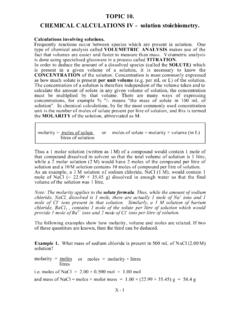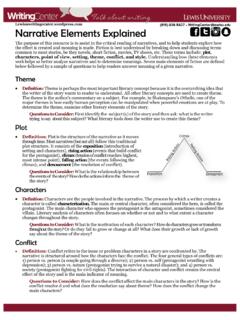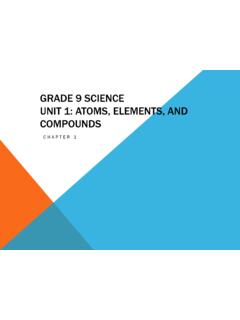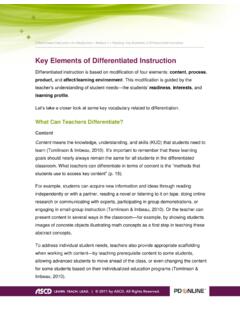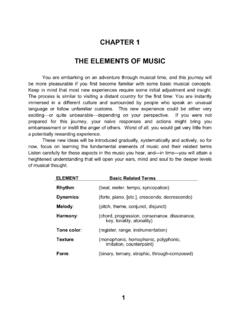Transcription of TOPIC 1. ELEMENTS, COMPOUNDS AND MIXTURES.
1 TOPIC 1. elements , COMPOUNDS AND mixtures . What is chemistry? Chemistry is the study of matter and the interconversion of matter. Matter is anything which has mass and occupies a volume. Sciences often begin by collecting and classifying. Subsequent observations lead to generalisations and laws. In the science of chemistry, there are numerous bases for classifying matter but the most fundamental is to subdivide matter into pure substances and mixtures . Pure substances can be further regarded as consisting of either elements or COMPOUNDS . MATTER. PURE SUBSTANCES mixtures .
2 An infinitely large number of mixtures is elements COMPOUNDS possible 90 naturally occurring An infinitely large elements + about 30 number of COMPOUNDS man-made elements is possible What characterises each of these groups? An ELEMENT is a substance which cannot be broken down into simpler component substances. An ATOM is the smallest possible unit of an element. Atoms are extremely small so any visible specimen of an element contains enormous numbers of atoms. Each element's atoms are unique to that element. There are only 90 naturally occurring elements so it follows that there are only 90.
3 Different types of naturally occurring atom. What distinguishes the atoms of each different element is the subject of another TOPIC . elements are conveniently further subdivided into two groups, METALS and NON-METALS, based on their physical and chemical properties. The physical properties of metals are probably already familiar - shiny when freshly cut, conduct heat and electricity well, malleable and ductile. The non-metals have the opposite properties to metals - they are usually powders or gases, do not conduct well and, if solids, are brittle. The chemical properties of each group will be discussed in future topics .
4 elements as they occur in nature rarely consist of discrete, individual atoms. Usually they consist of two or more atoms joined together by CHEMICAL. BONDS of various types. For example, oxygen, the essential life-supporting element in air, is not present as individual oxygen atoms but instead, consists of two oxygen atoms bonded together. This unit is called a MOLECULE of oxygen. Some elements occur as discrete molecules containing even larger numbers of atoms such as 4, 6, 10 or 12 bonded atoms. However, most elements including all the metals do not normally exist as discrete molecules containing a fixed number of atoms but instead, consist of very large aggregates of atoms bonded together.
5 I-1. I-2. Regardless of whether an element occurs as single atoms or as atoms bonded together, each element always consists of the same type of atom which imparts its own unique properties to that element. For example, aluminium is recognised as a silver-coloured metal while copper has a different colour. Apart from the obvious difference in colour, there are many unique physical and chemical properties which each of these two elements possess and which are attributable to the differences between their atoms. Table 1 (Page I-20) gives a complete alphabetical list of all the elements , including some of those synthesised.
6 In Table 2 (Page I-21), most of those elements are listed in groups containing four to six elements . Some of the groups are given names - for example, the elements of the first group collectively are known as the alkali metals, the seventh group is the halogens and the eight group is the noble gases. elements within each group have many properties in common. In addition, another 11 elements which are part of a much larger grouping known as the transition elements are listed in Table 2. Note that hydrogen does not belong to any group and is regarded as being an exceptional individual element.
7 COMPOUNDS . A compound differs from an element in that an element contains only a single type of atom while a compound consists of smallest units which contain at least two different types of atom ( atoms of at least two different elements ) joined together by chemical bonds. COMPOUNDS always contain atoms of their constituent elements in the same numerical ratio regardless of how the compound was prepared. Consequently analysis of any pure compound always returns the same result. Therefore a compound when pure is HOMOGENE OUS. Many COMPOUNDS exist as discrete molecules.
8 The smallest unit of the compound carbon dioxide is the carbon dioxide molecule, each of which consists of one carbon atom bonded to two oxygen atoms - this molecule is the smallest particle of carbon dioxide that can exist. The ratio of one carbon atom to two oxygen atoms in the molecule of this compound applies equally well to the carbon dioxide which may originate from burning of natural gas or petrol or from chemical reactions such as when an acid is mixed with a substance such as limestone or washing soda. Carbon dioxide molecules always consist of one carbon atom bonded to two oxygen atoms regardless of the source of the compound .
9 However, not all COMPOUNDS exist as discrete molecules - for example the compound sodium chloride also known as table salt exists not as individual sodium chloride molecules but as a highly structured crystal lattice, familiar as the rock salt commonly used in salt grinders. There are several types of chemical bonds that join atoms in elements and COMPOUNDS and the type of bond present determines in part whether a given compound exists as discrete molecules. Chemical bonds are examined in later topics . Note that when elements have combined to form COMPOUNDS , they lose their original properties and the compound formed has its own characteristic properties.
10 For example, carbon - a black solid - combines with another element, the colourless gas oxygen which supports combustion, to form the compound carbon dioxide which is a colourless gas that is incapable of supporting combustion. COMPOUNDS can only be converted back to their component elements by breaking the chemical bonds which hold the atoms together in the compound . For example, the compound water, which contains two hydrogen atoms and one oxygen atom I-3. combined in each water molecule can be converted to the free elements oxygen and hydrogen by passing an electric current through the water, a process called ELECTROLY SIS.




